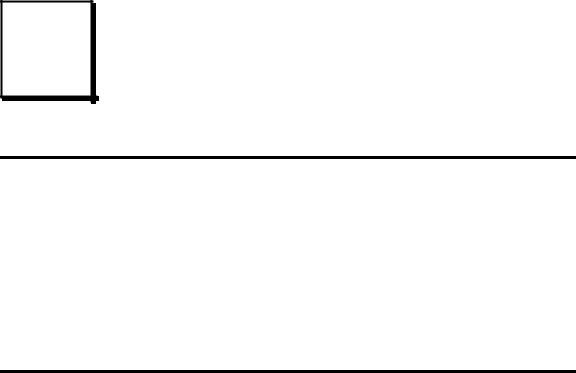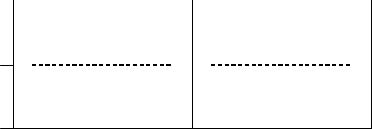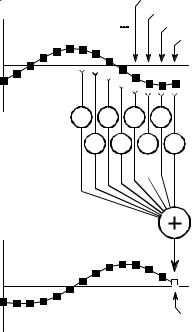

CHAPTER
Digital Signal Processors
28
Digital Signal Processing is carried out by mathematical operations. In comparison, word processing and similar programs merely rearrange stored data. This means that computers designed for business and other general applications are not optimized for algorithms such as digital filtering and Fourier analysis. Digital Signal Processors are microprocessors specifically designed to handle Digital Signal Processing tasks. These devices have seen tremendous growth in the last decade, finding use in everything from cellular telephones to advanced scientific instruments. In fact, hardware engineers use "DSP" to mean Digital Signal Processor, just as algorithm developers use "DSP" to mean Digital Signal Processing. This chapter looks at how DSPs are different from other types of microprocessors, how to decide if a DSP is right for your application, and how to get started in this exciting new field. In the next chapter we will take a more detailed look at one of these sophisticated products: the Analog Devices SHARC® family .
How DSPs are Different from Other Microprocessors
In the 1960s it was predicted that artificial intelligence would revolutionize the way humans interact with computers and other machines. It was believed that by the end of the century we would have robots cleaning our houses, computers driving our cars, and voice interfaces controlling the storage and retrieval of information. This hasn't happened; these abstract tasks are far more complicated than expected, and very difficult to carry out with the step-by-step logic provided by digital computers.
However, the last forty years have shown that computers are extremely capable in two broad areas, (1) data manipulation, such as word processing and database management, and (2) mathematical calculation, used in science, engineering, and Digital Signal Processing. All microprocessors can perform both tasks; however, it is difficult (expensive) to make a device that is optimized for both. There are technical tradeoffs in the hardware design, such as the size of the instruction set and how interrupts are handled. Even
503

504 |
The Scientist and Engineer's Guide to Digital Signal Processing |
Typical
Applications
Main
Operations
|
Data Manipulation |
|
Math Calculation |
|
|
|
|
|
|||
|
|
|
|
|
|
Word processing, database management, spread sheets, operating sytems, etc.
data movement (A º B) value testing (If A=B then ...)
Digital Signal Processing, motion control, scientific and engineering simulations, etc.
addition (A+B=C ) multiplication (A×B=C )
FIGURE 28-1
Data manipulation versus mathematical calculation. Digital computers are useful for two general tasks: data manipulation and mathematical calculation. Data manipulation is based on moving data and testing inequalities, while mathematical calculation uses multiplication and addition.
more important, there are marketing issues involved: development and manufacturing cost, competitive position, product lifetime, and so on. As a broad generalization, these factors have made traditional microprocessors, such as the Pentium®, primarily directed at data manipulation. Similarly, DSPs are designed to perform the mathematical calculations needed in Digital Signal Processing.
Figure 28-1 lists the most important differences between these two categories. Data manipulation involves storing and sorting information. For instance, consider a word processing program. The basic task is to store the information (typed in by the operator), organize the information (cut and paste, spell checking, page layout, etc.), and then retrieve the information (such as saving the document on a floppy disk or printing it with a laser printer). These tasks are accomplished by moving data from one location to another, and testing for inequalities (A=B, A<B, etc.). As an example, imagine sorting a list of words into alphabetical order. Each word is represented by an 8 bit number, the ASCII value of the first letter in the word. Alphabetizing involved rearranging the order of the words until the ASCII values continually increase from the beginning to the end of the list. This can be accomplished by repeating two steps over-and-over until the alphabetization is complete. First, test two adjacent entries for being in alphabetical order (IF A>B THEN ...). Second, if the two entries are not in alphabetical order, switch them so that they are (AWB). When this two step process is repeated many times on all adjacent pairs, the list will eventually become alphabetized.
As another example, consider how a document is printed from a word processor. The computer continually tests the input device (mouse or keyboard) for the binary code that indicates "print the document." When this code is detected, the program moves the data from the computer's memory to the printer. Here we have the same two basic operations: moving data and inequality testing. While mathematics is occasionally used in this type of

Chapter 28Digital Signal Processors |
505 |
application, it is infrequent and does not significantly affect the overall execution speed.
In comparison, the execution speed of most DSP algorithms is limited almost completely by the number of multiplications and additions required. For example, Fig. 28-2 shows the implementation of an FIR digital filter, the most common DSP technique. Using the standard notation, the input signal is referred to by x[ ], while the output signal is denoted by y[ ]. Our task is to calculate the sample at location n in the output signal, i.e., y[n] . An FIR filter performs this calculation by multiplying appropriate samples from the input signal by a group of coefficients, denoted by: a0, a1, a2, a3, þ, and then adding the products. In equation form, y[n] is found by:
y [n ] ' a0 x [n ] % a1 x [n&1] % a2 x [n&2] % a3 x [n&3] % a4 x [n&4] % þ
This is simply saying that the input signal has been convolved with a filter kernel (i.e., an impulse response) consisting of: a0, a1, a2, a3, þ. Depending on the application, there may only be a few coefficients in the filter kernel, or many thousands. While there is some data transfer and inequality evaluation in this algorithm, such as to keep track of the intermediate results and control the loops, the math operations dominate the execution time.
FIGURE 28-2
FIR digital filter. In FIR filtering, each sample in the output signal, y[n], is found by multiplying samples from the input signal, x[n], x[n-1], x[n-2], ..., by the filter kernel coefficients, a0, a1, a2, a3 ..., and summing the products.
Input Signal, x[ ] |
|
|
|
x[n-3] |
|
|
|
|
|
x[n-2] |
|
|
|
|
|
|
|
|
|
|
|
|
x[n-1] |
|
|
|
|
|
x[n] |
× a7 |
× a5 |
× a3 |
× a1 |
||
× a6 |
× a4 |
× a2 |
× a0 |
||
Output signal, y[ ]
y[n] |
506 |
The Scientist and Engineer's Guide to Digital Signal Processing |
In addition to preforming mathematical calculations very rapidly, DSPs must also have a predictable execution time. Suppose you launch your desktop computer on some task, say, converting a word-processing document from one form to another. It doesn't matter if the processing takes ten milliseconds or ten seconds; you simply wait for the action to be completed before you give the computer its next assignment.
In comparison, most DSPs are used in applications where the processing is continuous, not having a defined start or end. For instance, consider an engineer designing a DSP system for an audio signal, such as a hearing aid. If the digital signal is being received at 20,000 samples per second, the DSP must be able to maintain a sustained throughput of 20,000 samples per second. However, there are important reasons not to make it any faster than necessary. As the speed increases, so does the cost, the power consumption, the design difficulty, and so on. This makes an accurate knowledge of the execution time critical for selecting the proper device, as well as the algorithms that can be applied.
Circular Buffering
Digital Signal Processors are designed to quickly carry out FIR filters and similar techniques. To understand the hardware, we must first understand the algorithms. In this section we will make a detailed list of the steps needed to implement an FIR filter. In the next section we will see how DSPs are designed to perform these steps as efficiently as possible.
To start, we need to distinguish between off-line processing and real-time processing. In off-line processing, the entire input signal resides in the computer at the same time. For example, a geophysicist might use a seismometer to record the ground movement during an earthquake. After the shaking is over, the information may be read into a computer and analyzed in some way. Another example of off-line processing is medical imaging, such as computed tomography and MRI. The data set is acquired while the patient is inside the machine, but the image reconstruction may be delayed until a later time. The key point is that all of the information is simultaneously available to the processing program. This is common in scientific research and engineering, but not in consumer products. Off-line processing is the realm of personal computers and mainframes.
In real-time processing, the output signal is produced at the same time that the input signal is being acquired. For example, this is needed in telephone communication, hearing aids, and radar. These applications must have the information immediately available, although it can be delayed by a short amount. For instance, a 10 millisecond delay in a telephone call cannot be detected by the speaker or listener. Likewise, it makes no difference if a radar signal is delayed by a few seconds before being displayed to the operator. Real-time applications input a sample, perform the algorithm, and output a sample, over-and-over. Alternatively, they may input a group

|
|
|
|
|
Chapter 28Digital Signal Processors |
|
|
|
507 |
|||||||
MEMORY |
STORED |
|
|
|
|
|
MEMORY |
STORED |
|
|
|
|
|
|
||
ADDRESS |
VALUE |
|
|
|
|
|
ADDRESS |
VALUE |
|
|
|
|
|
|
||
20040 |
|
|
|
|
|
|
|
20040 |
|
|
|
|
|
|
|
|
|
|
|
|
|
|
|
|
|
|
|
|
|
|
|
||
20041 |
-0.225767 |
|
|
x[n-3] |
|
|
20041 |
-0.225767 |
|
|
x[n-4] |
|
|
|
||
|
|
|
|
|
|
|
|
|||||||||
20042 |
-0.269847 |
|
|
x[n-2] |
|
|
20042 |
-0.269847 |
|
|
x[n-3] |
|
|
|
||
20043 |
-0.228918 |
|
|
x[n-1] |
|
|
20043 |
-0.228918 |
|
|
x[n-2] |
|
|
|
||
|
|
|
|
|
|
|
|
|||||||||
|
|
|
|
|
x[n] |
newest sample |
|
|
|
|
|
x[n-1] |
|
|
|
|
20044 |
-0.113940 |
|
|
20044 |
-0.113940 |
|
|
|
|
|
||||||
|
|
|
|
|
|
|||||||||||
20045 |
|
|
|
|
x[n-7] |
oldest sample |
20045 |
|
|
|
|
x[n] |
newest sample |
|
||
-0.048679 |
|
|
-0.062222 |
|
|
|
||||||||||
|
|
|
||||||||||||||
|
|
|
|
|
x[n-6] |
|
|
|
|
|
|
|
x[n-7] |
oldest sample |
|
|
20046 |
-0.222977 |
|
|
|
|
20046 |
-0.222977 |
|
|
|
||||||
|
|
|
|
|||||||||||||
|
|
|
|
|
||||||||||||
|
|
|
|
|
x[n-5] |
|
|
|
|
|
|
|
x[n-6] |
|
|
|
20047 |
-0.371370 |
|
|
|
|
20047 |
-0.371370 |
|
|
|
|
|
||||
|
|
|
|
|
|
|
|
|
||||||||
|
|
|
|
|
|
|
|
|||||||||
20048 |
|
|
|
|
x[n-4] |
|
|
20048 |
|
|
|
|
x[n-5] |
|
|
|
-0.462791 |
|
|
|
|
-0.462791 |
|
|
|
|
|
||||||
|
|
|
|
|
|
|
|
|||||||||
20049 |
|
|
|
|
|
|
|
20049 |
|
|
|
|
|
|
|
|
|
|
|
|
|
|
|
|
|
|
|
|
|
|
|
||
|
|
|
|
|
|
|
|
|
|
|
|
|
|
|
||
a. |
Circular buffer at some instant |
b. Circular buffer after next sample |
||||||||||||||
FIGURE 28-3
Circular buffer operation. Circular buffers are used to store the most recent values of a continually updated signal. This illustration shows how an eight sample circular buffer might appear at some instant in time (a), and how it would appear one sample later (b).
of samples, perform the algorithm, and output a group of samples. This is the world of Digital Signal Processors.
Now look back at Fig. 28-2 and imagine that this is an FIR filter being implemented in real-time. To calculate the output sample, we must have access to a certain number of the most recent samples from the input. For example, suppose we use eight coefficients in this filter, a0, a1, þ a7 . This means we must know the value of the eight most recent samples from the input signal, x[n], x[n& 1], þ x[n& 7] . These eight samples must be stored in memory and continually updated as new samples are acquired. What is the best way to manage these stored samples? The answer is circular buffering.
Figure 28-3 illustrates an eight sample circular buffer. We have placed this circular buffer in eight consecutive memory locations, 20041 to 20048. Figure
(a) shows how the eight samples from the input might be stored at one particular instant in time, while (b) shows the changes after the next sample is acquired. The idea of circular buffering is that the end of this linear array is connected to its beginning; memory location 20041 is viewed as being next to 20048, just as 20044 is next to 20045. You keep track of the array by a pointer (a variable whose value is an address) that indicates where the most recent sample resides. For instance, in (a) the pointer contains the address 20044, while in (b) it contains 20045. When a new sample is acquired, it replaces the oldest sample in the array, and the pointer is moved one address ahead. Circular buffers are efficient because only one value needs to be changed when a new sample is acquired.
Four parameters are needed to manage a circular buffer. First, there must be a pointer that indicates the start of the circular buffer in memory (in this example, 20041). Second, there must be a pointer indicating the end of the

508 |
The Scientist and Engineer's Guide to Digital Signal Processing |
TABLE 28-1 FIR filter steps.
array (e.g., 20048), or a variable that holds its length (e.g., 8). Third, the step size of the memory addressing must be specified. In Fig. 28-3 the step size is one, for example: address 20043 contains one sample, address 20044 contains the next sample, and so on. This is frequently not the case. For instance, the addressing may refer to bytes, and each sample may require two or four bytes to hold its value. In these cases, the step size would need to be two or four, respectively.
These three values define the size and configuration of the circular buffer, and will not change during the program operation. The fourth value, the pointer to the most recent sample, must be modified as each new sample is acquired. In other words, there must be program logic that controls how this fourth value is updated based on the value of the first three values. While this logic is quite simple, it must be very fast. This is the whole point of this discussion; DSPs should be optimized at managing circular buffers to achieve the highest possible execution speed.
As an aside, circular buffering is also useful in off-line processing. Consider a program where both the input and the output signals are completely contained in memory. Circular buffering isn't needed for a convolution calculation, because every sample can be immediately accessed. However, many algorithms are implemented in stages, with an intermediate signal being created between each stage. For instance, a recursive filter carried out as a series of biquads operates in this way. The brute force method is to store the entire length of each intermediate signal in memory. Circular buffering provides another option: store only those intermediate samples needed for the calculation at hand. This reduces the required amount of memory, at the expense of a more complicated algorithm. The important idea is that circular buffers are useful for off-line processing, but critical for real-time applications.
Now we can look at the steps needed to implement an FIR filter using circular buffers for both the input signal and the coefficients. This list may seem trivial and overexaminedit's not! The efficient handling of these individual tasks is what separates a DSP from a traditional microprocessor. For each new sample, all the following steps need to be taken:
1.Obtain a sample with the ADC; generate an interrupt
2.Detect and manage the interrupt
3.Move the sample into the input signal's circular buffer
4.Update the pointer for the input signal's circular buffer
5.Zero the accumulator
6. Control the loop through each of the coefficients
7.Fetch the coefficient from the coefficient's circular buffer
8.Update the pointer for the coefficient's circular buffer
9.Fetch the sample from the input signal's circular buffer 10. Update the pointer for the input signal's circular buffer 11. Multiply the coefficient by the sample
12. Add the product to the accumulator
13.Move the output sample (accumulator) to a holding buffer
14.Move the output sample from the holding buffer to the DAC
